An Improved Carrier-Based PWM Strategy with Reduced Common-Mode Voltage for a Three-Level NPC Inverter
Abstract
:1. Introduction
2. Neutral-Point Current and CMV of the Three-Level NPC
2.1. Neutral-Point Current
2.2. Common-Mode Voltage
2.3. Virtual Vectors
3. Derivation of the Proposed Hybrid CBPWM
3.1. Principle of the Operation
3.2. CMV Reduction
3.3. Harmonic Content
3.4. Neutral Point Voltage Deviation
4. Active NPV Controller
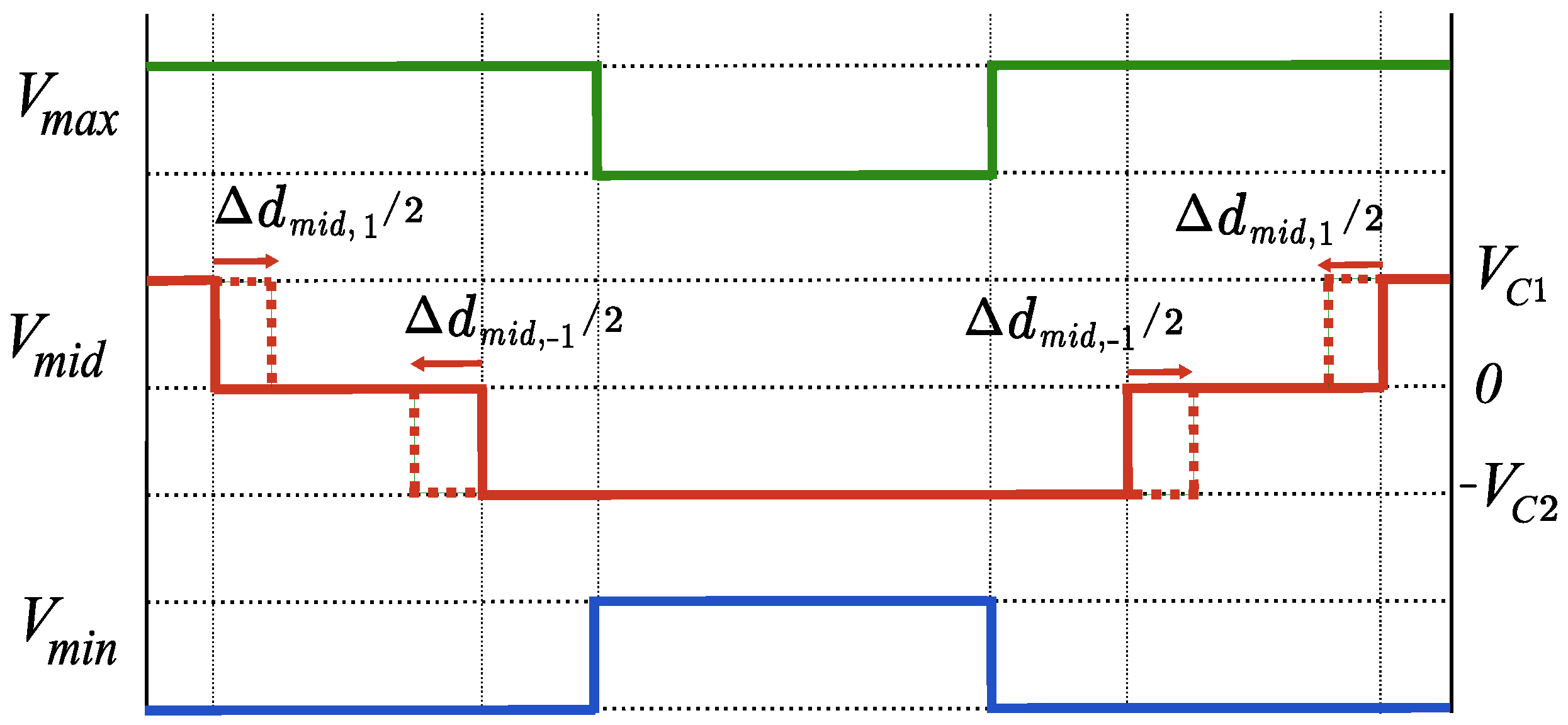
5. Experimental Results
6. Conclusions
Author Contributions
Funding
Data Availability Statement
Conflicts of Interest
References
- Wang, Y.; Poorfakhraei, A.; Mehdi, N.; Emadi, A. Comparative Analysis of 2-Level and 3-Level Voltage Source Inverters in Traction Applications. In Proceedings of the IEEE Transportation Electrification Conference Expo (ITEC), Chicago, IL, USA, 21–25 June 2021; pp. 614–619. [Google Scholar] [CrossRef]
- Kersten, A.; Oberdieck, K.; Gossmann, J.; Bubert, A.; Loewenherz, R.; Neubert, M.; Thiringer, T.; Doncker, R.W.D. Measuring and Separating Conducted Three-Wire Emissions From a Fault-Tolerant, NPC Propulsion Inverter With a Split-Battery Using Hardware Separators Based on HF Transformers. IEEE Trans. Power Electron. 2021, 36, 378–390. [Google Scholar] [CrossRef]
- Busquets-Monge, S.; Bordonau, J.; Boroyevich, D.; Somavilla, S. The nearest three virtual space vector PWM—A modulation for the comprehensive neutral-point balancing in the three-level NPC inverter. IEEE Power Electron. Lett. 2004, 2, 11–15. [Google Scholar] [CrossRef]
- Busquets-Monge, S.; Ortega, J.D.; Bordonau, J.; Beristain, J.A.; Rocabert, J. Closed-Loop Control of a Three-Phase Neutral-Point-Clamped Inverter Using an Optimized Virtual-Vector-Based Pulsewidth Modulation. IEEE Trans. Ind. Electron. 2008, 55, 2061–2071. [Google Scholar] [CrossRef]
- Busquets Monge, S.; Somavilla, S.; Bordonau, J.; Boroyevich, D. Capacitor Voltage Balance for the Neutral-Point- Clamped Converter using the Virtual Space Vector Concept With Optimized Spectral Performance. IEEE Trans. Power Electron. 2007, 22, 1128–1135. [Google Scholar] [CrossRef]
- Xiang, C.Q.; Shu, C.; Han, D.; Mao, B.K.; Wu, X.; Yu, T.J. Improved Virtual Space Vector Modulation for Three-Level Neutral-Point-Clamped Converter With Feedback of Neutral-Point Voltage. IEEE Trans. Power Electron. 2018, 33, 5452–5464. [Google Scholar] [CrossRef]
- Wu, X.; Tan, G.; Ye, Z.; Yao, G.; Liu, Z.; Liu, G. Virtual-Space-Vector PWM for a Three-Level Neutral-Point-Clamped Inverter with Unbalanced DC-Links. IEEE Trans. Power Electron. 2018, 33, 2630–2642. [Google Scholar] [CrossRef]
- Qin, C.; Li, X. Improved Virtual Space Vector Modulation Scheme for the Reduced Switch Count Three-Level Inverter with Unbalanced Neutral-Point Voltage Conditions. In Proceedings of the 2022 IEEE Energy Conversion Congress and Exposition (ECCE), Detroit, MI, USA, 9–13 October 2022; pp. 1–6. [Google Scholar] [CrossRef]
- Wang, J.; Gao, Y.; Jiang, W. A Carrier-Based Implementation of Virtual Space Vector Modulation for Neutral-Point-Clamped Three-Level Inverter. IEEE Trans. Ind. Electron. 2017, 64, 9580–9586. [Google Scholar] [CrossRef]
- Jiang, W.; Huang, X.; Wang, J.; Wang, J.; Li, J. A Carrier-Based PWM Strategy Providing Neutral-Point Voltage Oscillation Elimination for Multi-Phase Neutral Point Clamped 3-Level Inverter. IEEE Access 2019, 7, 124066–124076. [Google Scholar] [CrossRef]
- Weidong, J.; Wang, L.; Wang, J.; Zhang, X.; Wang, P. A Carrier-Based Virtual Space Vector Modulation With Active Neutral-Point Voltage Control for a Neutral-Point-Clamped Three-Level Inverter. IEEE Trans. Ind. Electron. 2018, 65, 8687–8696. [Google Scholar] [CrossRef]
- Hava, A.M.; Ün, E. A High-Performance PWM Algorithm for Common-Mode Voltage Reduction in Three-Phase Voltage Source Inverters. IEEE Trans. Power Electron. 2011, 26, 1998–2008. [Google Scholar] [CrossRef]
- Robles, E.; Fernandez, M.; Zaragoza, J.; Aretxabaleta, I.; De Alegria, I.M.; Andreu, J. Common-Mode Voltage Elimination in Multilevel Power Inverter-Based Motor Drive Applications. IEEE Access 2022, 10, 2117–2139. [Google Scholar] [CrossRef]
- Zhang, H.; Von Jouanne, A.; Dai, S.; Wallace, A.; Wang, F. Multilevel inverter modulation schemes to eliminate common-mode voltages. IEEE Trans. Ind. Appl. 2000, 36, 1645–1653. [Google Scholar] [CrossRef]
- Jiang, W.; Wang, P.; Ma, M.; Wang, J.; Li, J.; Li, L.; Chen, K. A Novel Virtual Space Vector Modulation With Reduced Common-Mode Voltage and Eliminated Neutral Point Voltage Oscillation for Neutral Point Clamped Three-Level Inverter. IEEE Trans. Ind. Electron. 2020, 67, 884–894. [Google Scholar] [CrossRef]
- Guo, F.; Yang, T.; Diab, A.M.; Yeoh, S.S.; Bozhko, S.; Wheeler, P. An Enhanced Virtual Space Vector Modulation Scheme of Three-Level NPC Converters for More-Electric-Aircraft Applications. IEEE Trans. Ind. Appl. 2021, 57, 5239–5251. [Google Scholar] [CrossRef]
- Xia, S.; Wu, X.; Zheng, J.; Li, X.; Wang, K. A Virtual Space Vector PWM With Active Neutral Point Voltage Control and Common Mode Voltage Suppression for Three-Level NPC Converters. IEEE Trans. Ind. Electron. 2021, 68, 11761–11771. [Google Scholar] [CrossRef]
- Hu, C.; Yu, X.; Holmes, D.G.; Shen, W.; Wang, Q.; Luo, F.; Liu, N. An Improved Virtual Space Vector Modulation Scheme for Three-Level Active Neutral-Point-Clamped Inverter. IEEE Trans. Power Electron. 2017, 32, 7419–7434. [Google Scholar] [CrossRef]
- Liu, P.; Duan, S.; Yao, C.; Chen, C. A Double Modulation Wave CBPWM Strategy Providing Neutral-Point Voltage Oscillation Elimination and CMV Reduction for Three-Level NPC Inverters. IEEE Trans. Ind. Electron. 2018, 65, 16–26. [Google Scholar] [CrossRef]
- Pou, J.; Zaragoza, J.; Rodriguez, P.; Ceballos, S.; Sala, V.M.; Burgos, R.P.; Boroyevich, D. Fast-Processing Modulation Strategy for the Neutral-Point-Clamped Converter With Total Elimination of Low-Frequency Voltage Oscillations in the Neutral Point. IEEE Trans. Ind. Electron. 2007, 54, 2288–2294. [Google Scholar] [CrossRef]
- Prieto, J.; Jones, M.; Barrero, F.; Levi, E.; Toral, S. Comparative Analysis of Discontinuous and Continuous PWM Techniques in VSI-Fed Five-Phase Induction Motor. IEEE Trans. Ind. Electron. 2011, 58, 5324–5335. [Google Scholar] [CrossRef]
- Glose, D.; Kennel, R. Continuous Space Vector Modulation for Symmetrical Six-Phase Drives. IEEE Trans. Power Electron. 2016, 31, 3837–3848. [Google Scholar] [CrossRef]
- Beniwal, N.; Townsend, C.D.; Farivar, G.G.; Pou, J.; Ceballos, S.; Tafti, H.D. Band-Limited Three-Level Modulation for Balancing Capacitor Voltages in Neutral-Point-Clamped Converters. IEEE Trans. Power Electron. 2020, 35, 9737–9752. [Google Scholar] [CrossRef]


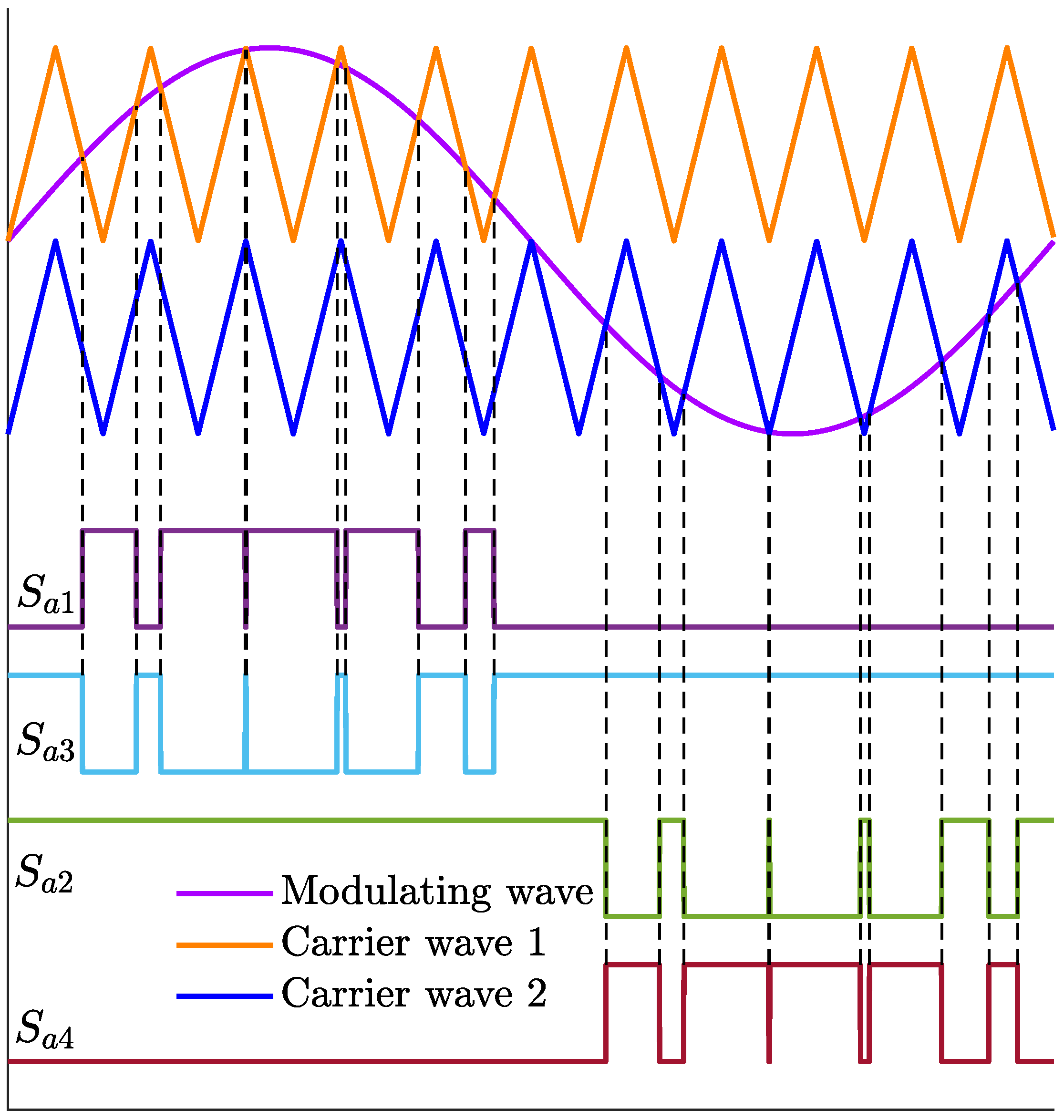
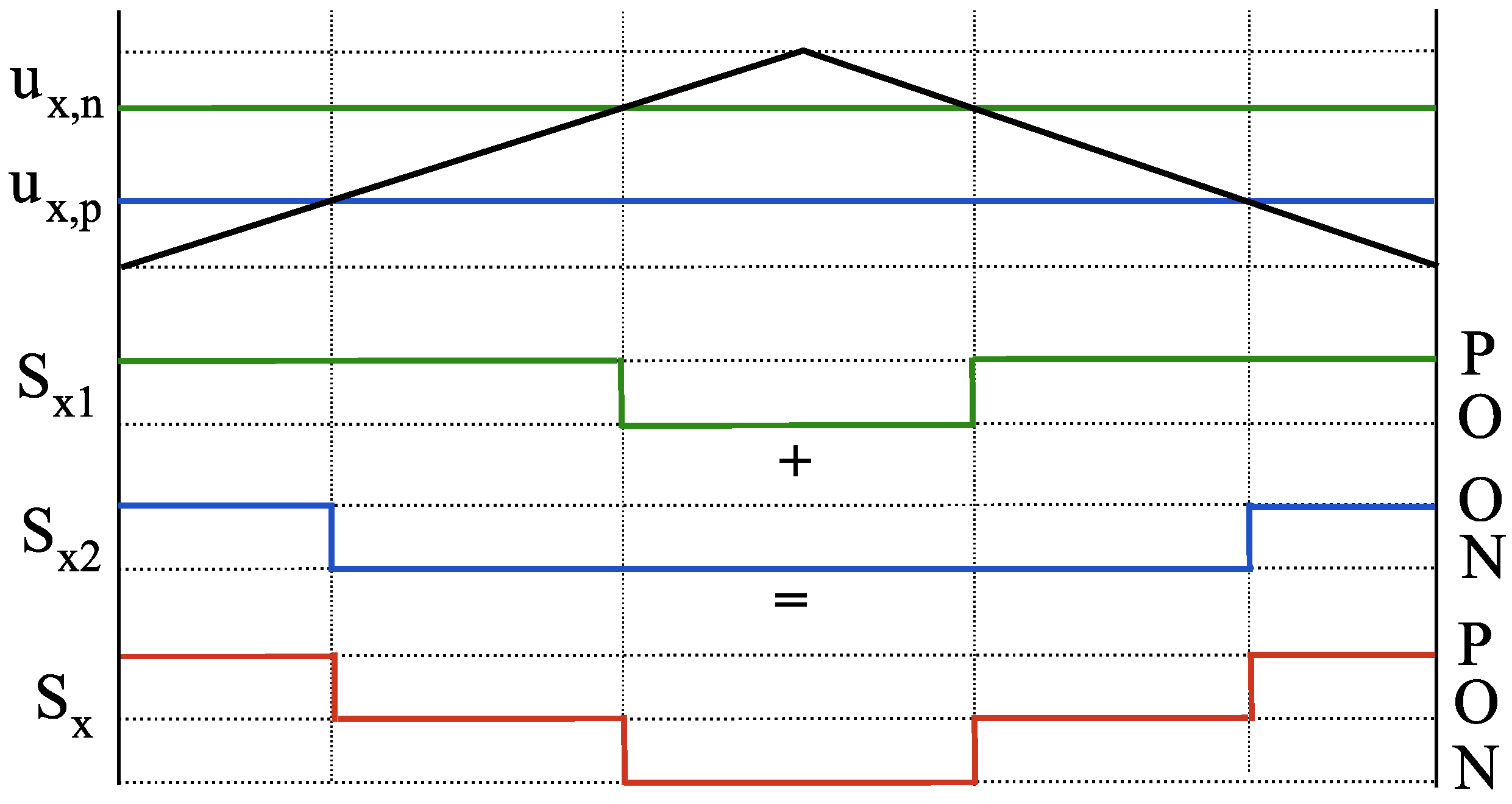

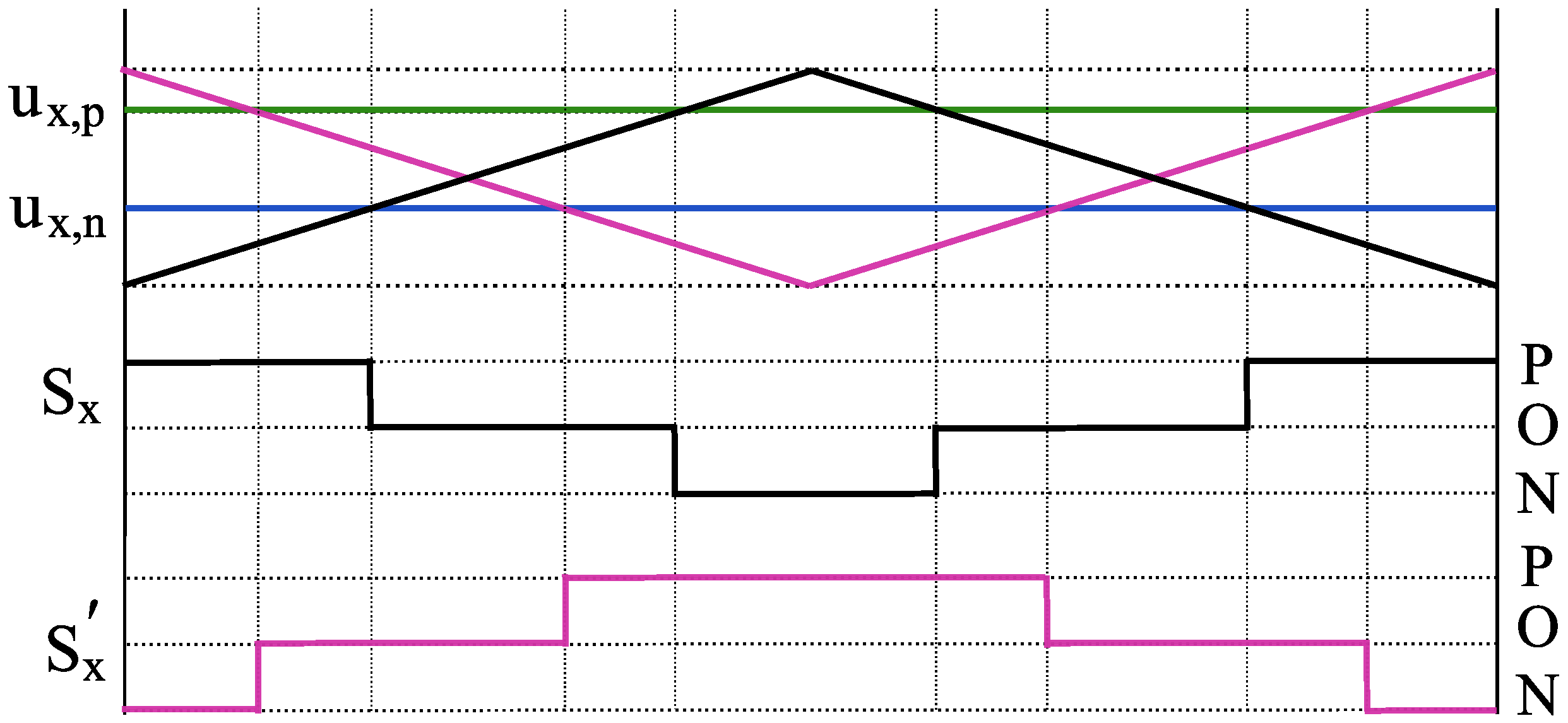
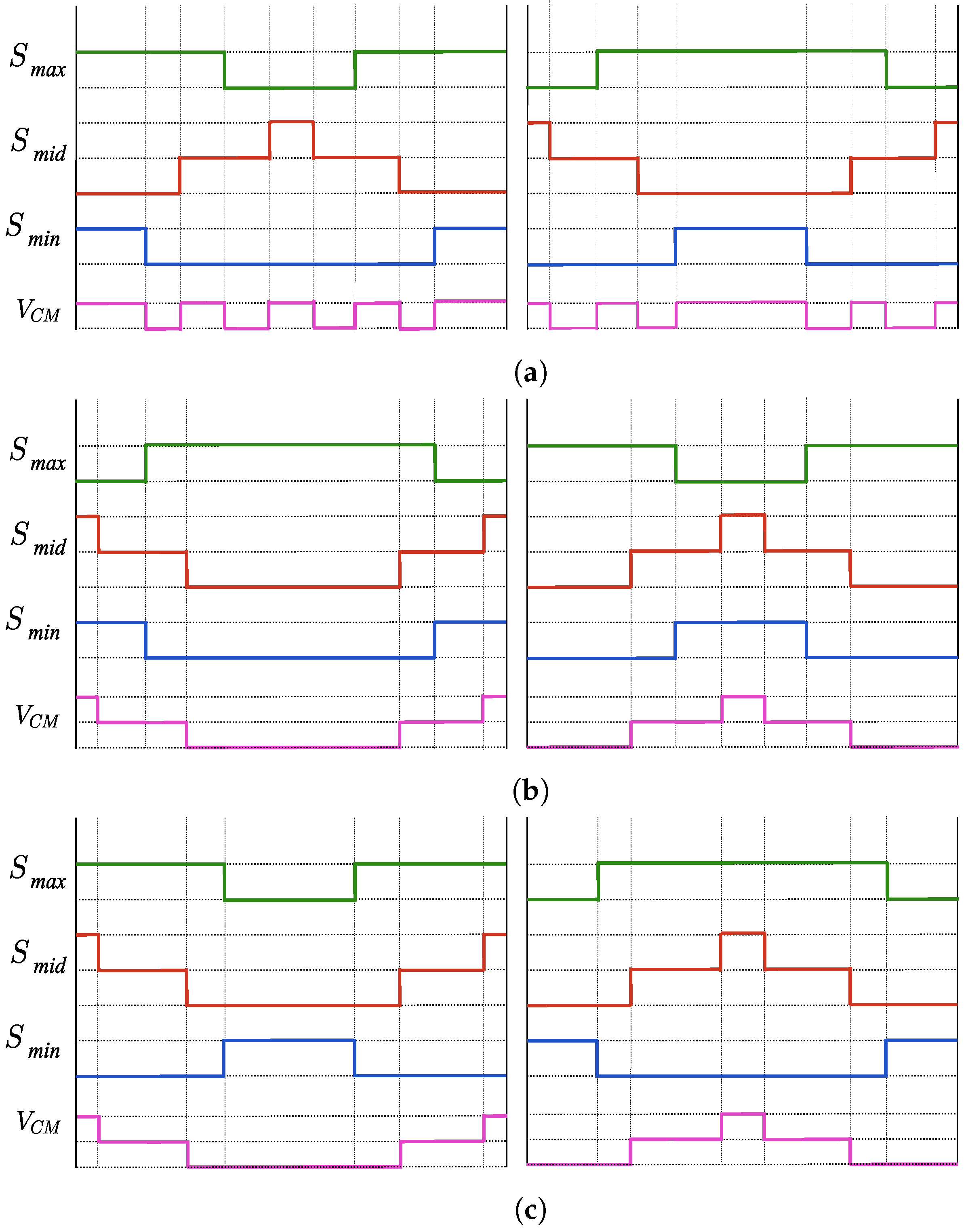
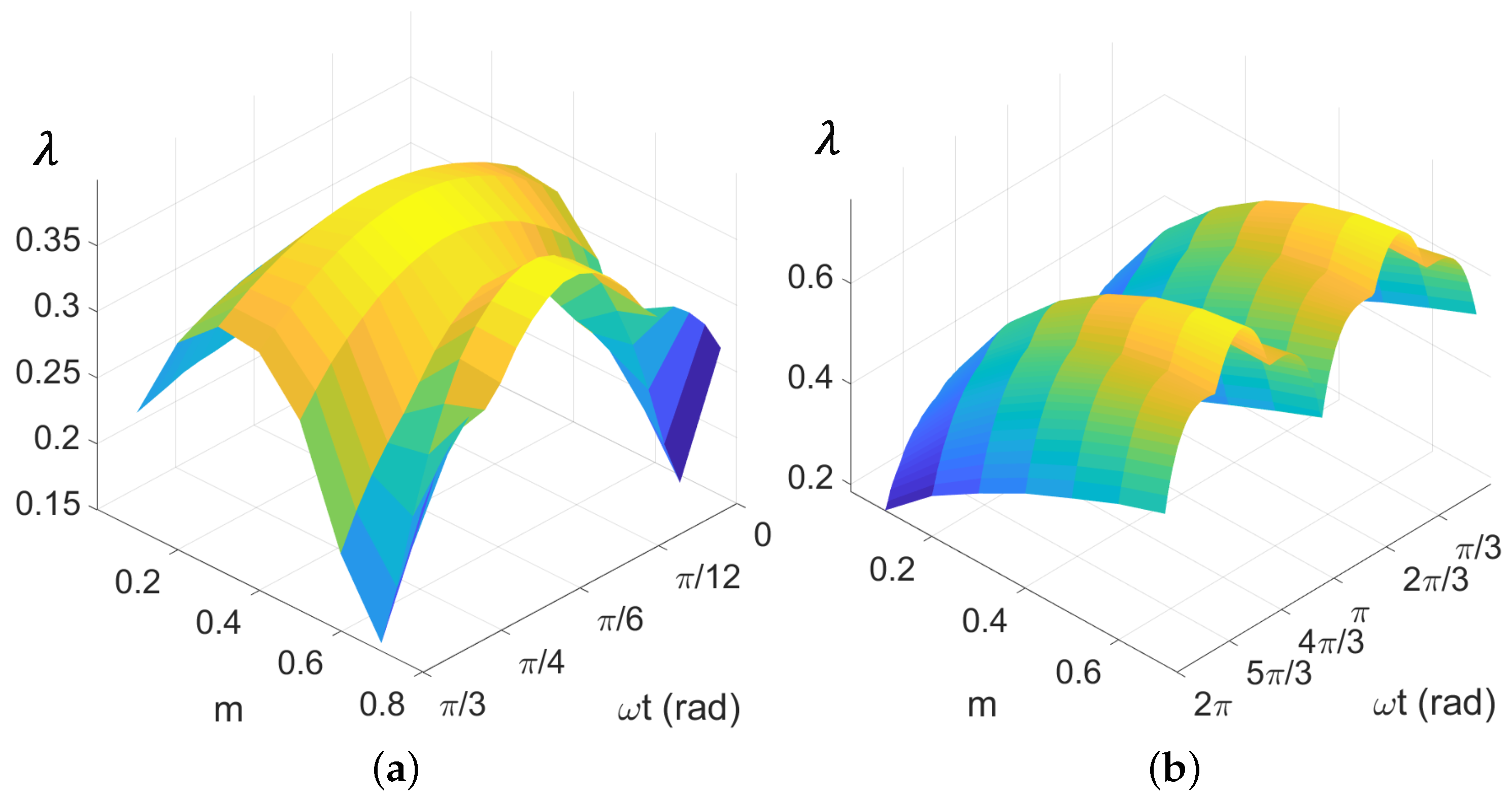
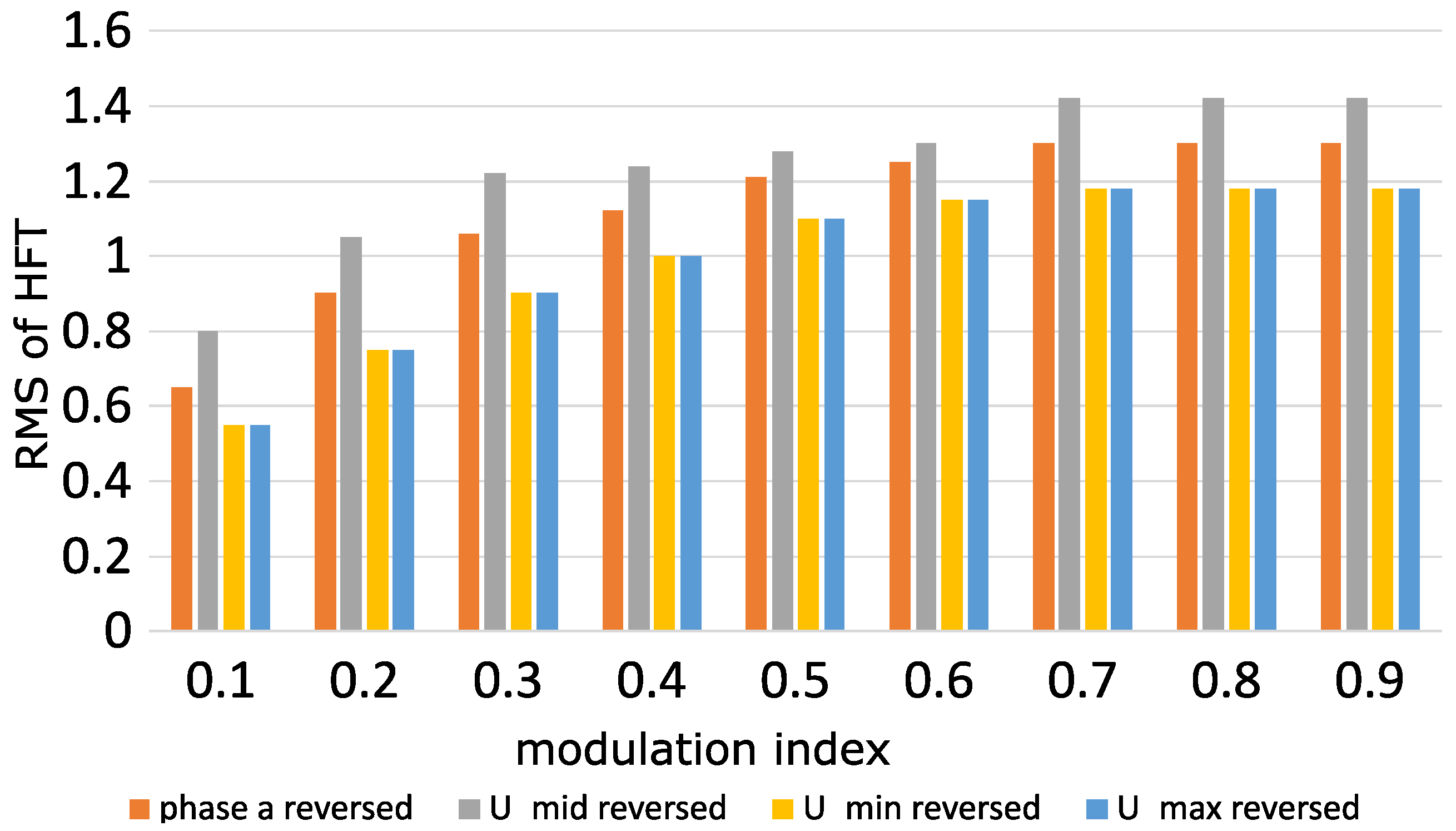

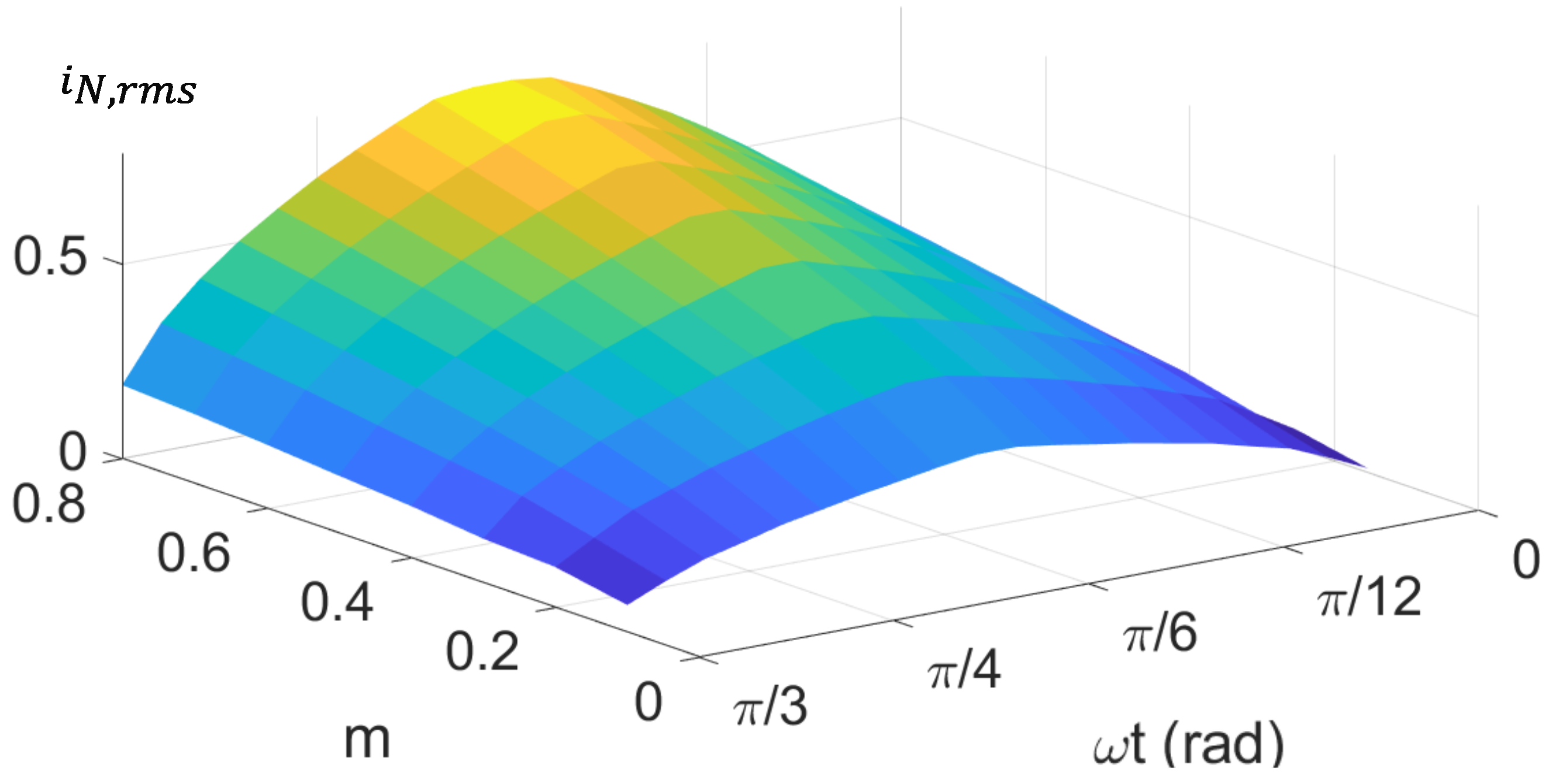
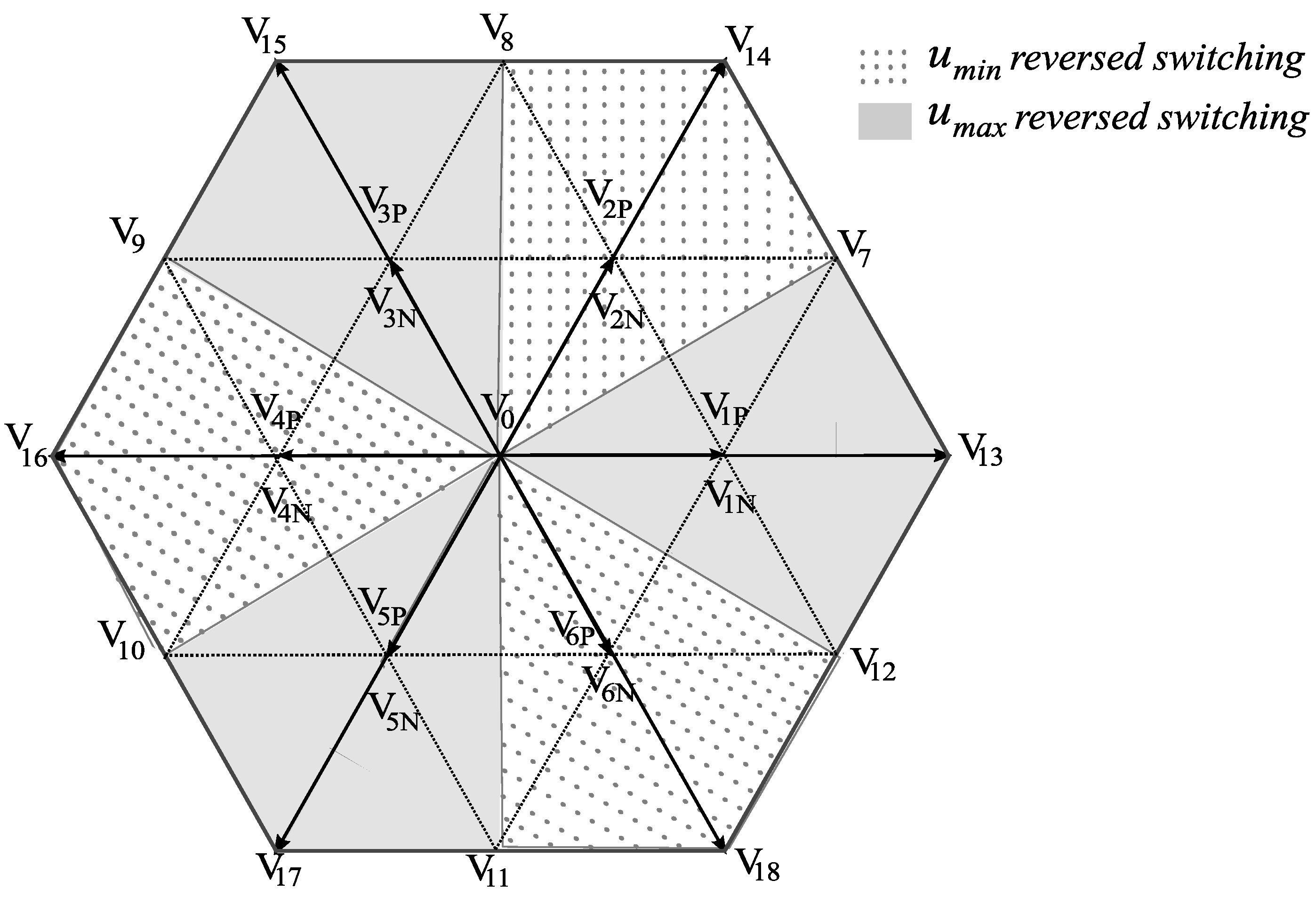
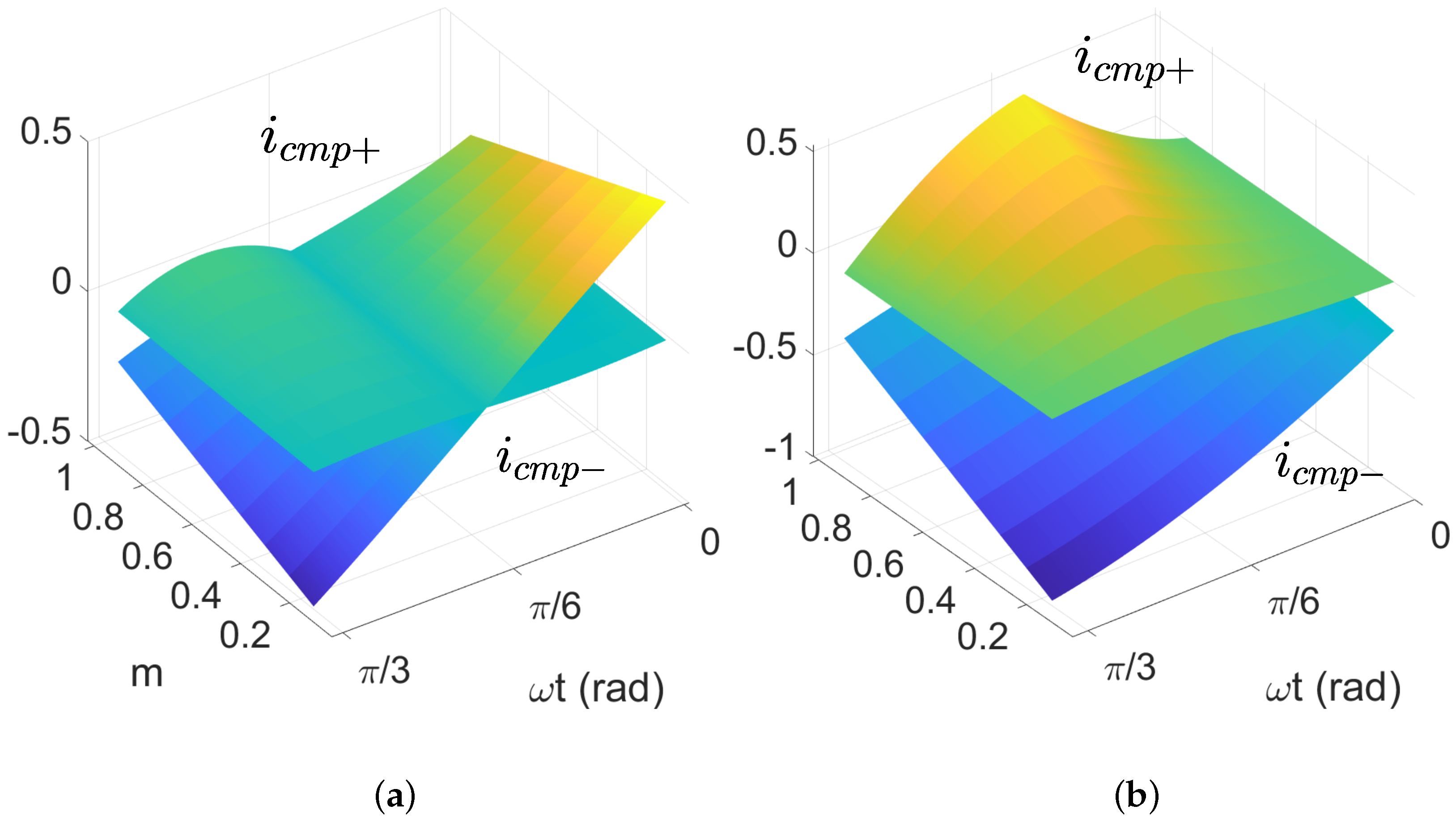

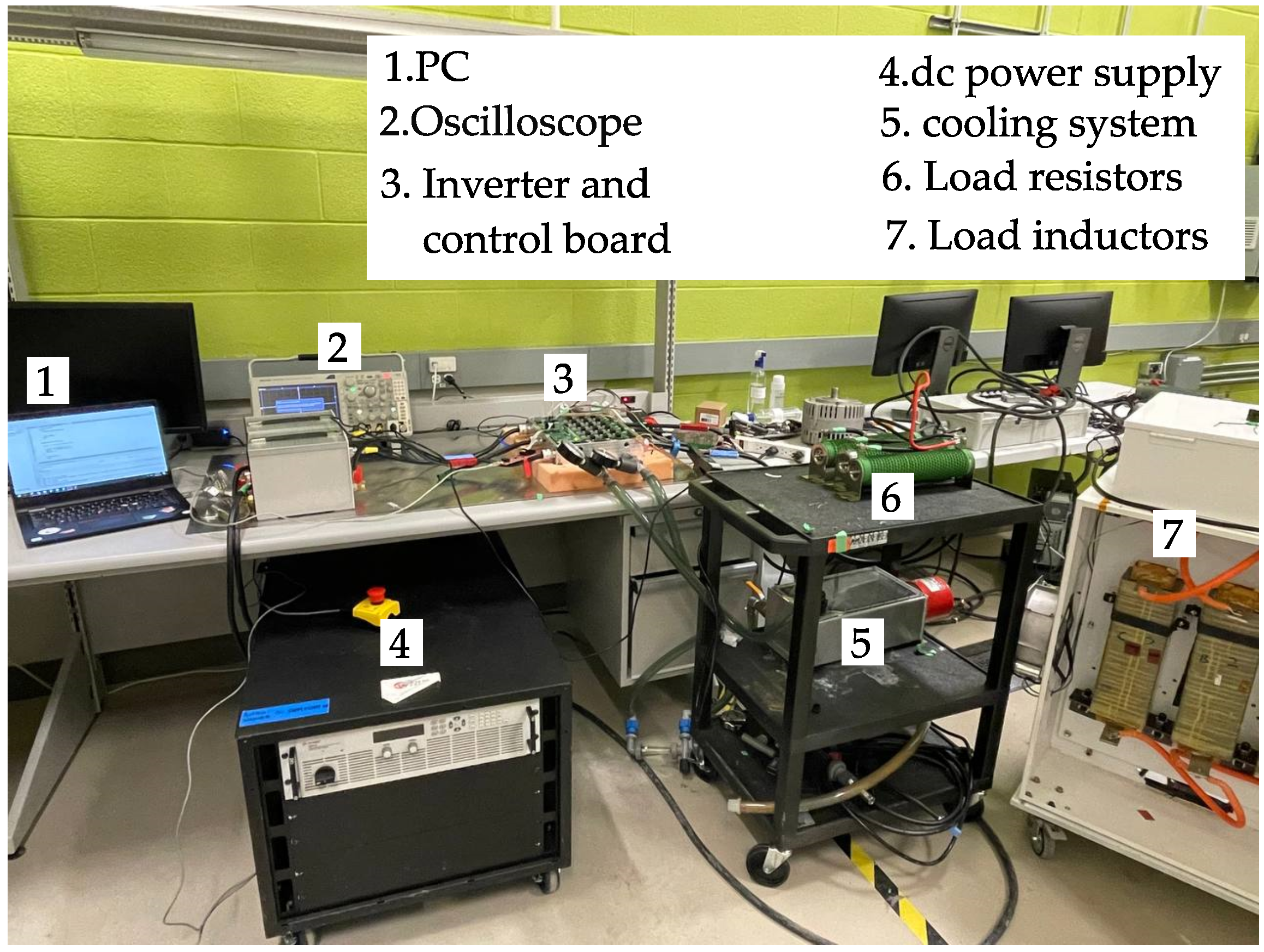
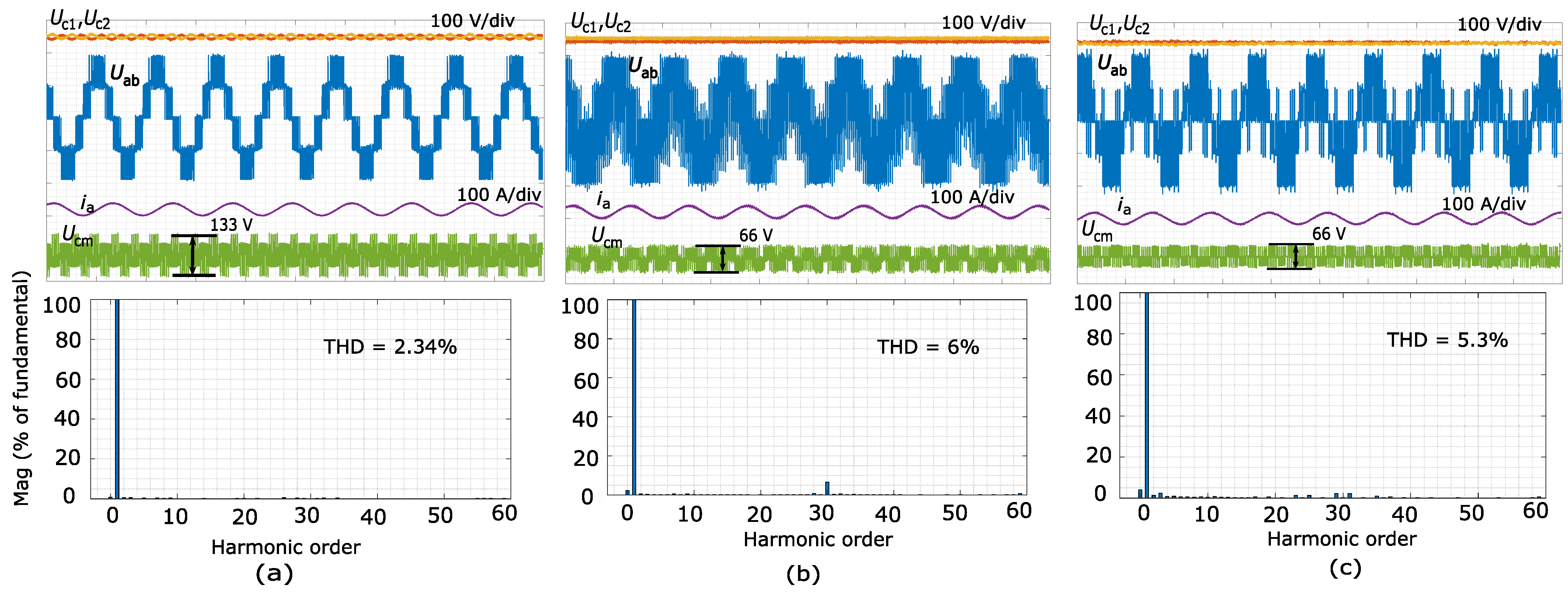
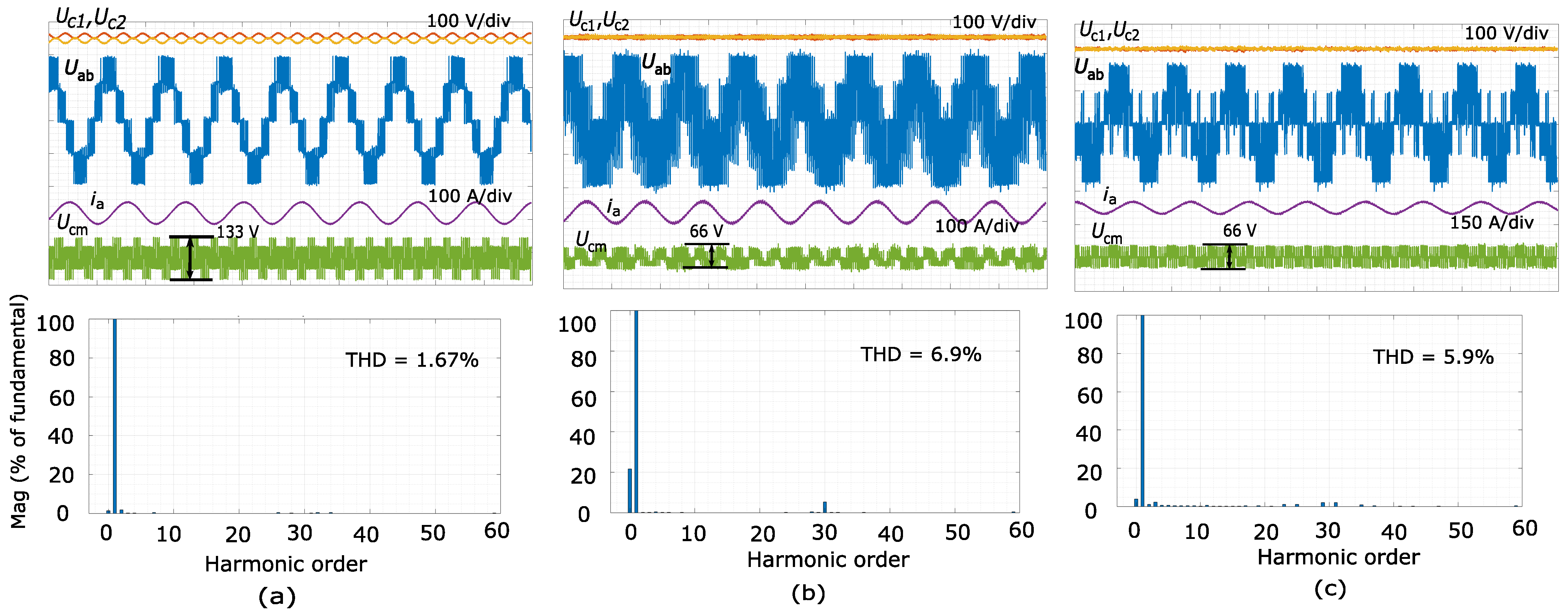

| Switching State | Device Switching Status | Output Phase Voltage | ||||||
|---|---|---|---|---|---|---|---|---|
| [P] | 1 | 1 | 0 | 0 | 0 | 1 | ||
| [O] | OU1 1 | 0 | 1 | 0 | 0 | 1 | 0 | 0 |
| OU2 1 | 0 | 1 | 0 | 1 | 1 | 0 | ||
| OL1 2 | 1 | 0 | 1 | 0 | 0 | 1 | ||
| OL2 2 | 0 | 0 | 1 | 0 | 0 | 1 | ||
| [N] | 0 | 0 | 1 | 1 | 1 | 0 | ||
| Mediums Vectors | Small Vectors | ||||
|---|---|---|---|---|---|
| Vectors | CMV | |
|---|---|---|
| zero vector | (OOO) | 0 |
| zero vector | ((PPP), (NNN) | |
| small vectors1 | (POO), (OON), (OPO) | |
| (NOO), (OOP), (ONO) | ||
| small vectors2 | (ONN), (PPO), (NON) | |
| (OPP), (NNO), (POP) | ||
| medium vectors | (PON), (OPN), (NPO) | 0 |
| (NOP), (ONP), (PNO) | ||
| large vectors | (PNN), (PPN), (NPN) | |
| (NPP), (NNP), (PNP) |
| Symbol | Description | Value |
|---|---|---|
| input DC voltage | 200 V | |
| switching frequency | 50 kHz | |
| fundamental frequency | 833 Hz | |
| DC-link capacitors | 72 F | |
| m | modulation index | 0.75 |
| L | load inductance | 200 H |
| R | load resistance | 1 |
| conventional CBPWM | 31.2 | 1 | 2.04 |
| RCMV-CBPWM | 11.37 | 1.17 | 0.08 |
| proposed RCMV-CBPWM | 6.6 | 0.83 | 0.05 |
| conventional CBPWM | 32.6 | 0.68 | 2 |
| RCMV-CBPWM | 15.9 | 1.37 | 0.6 |
| proposed RCMV-CBPWM | 12.8 | 1.2 | 0.24 |
Disclaimer/Publisher’s Note: The statements, opinions and data contained in all publications are solely those of the individual author(s) and contributor(s) and not of MDPI and/or the editor(s). MDPI and/or the editor(s) disclaim responsibility for any injury to people or property resulting from any ideas, methods, instructions or products referred to in the content. |
© 2023 by the authors. Licensee MDPI, Basel, Switzerland. This article is an open access article distributed under the terms and conditions of the Creative Commons Attribution (CC BY) license (https://creativecommons.org/licenses/by/4.0/).
Share and Cite
AbolqasemiKharanaq, F.; Poorfakhraei, A.; Emadi, A.; Bilgin, B. An Improved Carrier-Based PWM Strategy with Reduced Common-Mode Voltage for a Three-Level NPC Inverter. Electronics 2023, 12, 1072. https://doi.org/10.3390/electronics12051072
AbolqasemiKharanaq F, Poorfakhraei A, Emadi A, Bilgin B. An Improved Carrier-Based PWM Strategy with Reduced Common-Mode Voltage for a Three-Level NPC Inverter. Electronics. 2023; 12(5):1072. https://doi.org/10.3390/electronics12051072
Chicago/Turabian StyleAbolqasemiKharanaq, Fatemeh, Amirreza Poorfakhraei, Ali Emadi, and Berker Bilgin. 2023. "An Improved Carrier-Based PWM Strategy with Reduced Common-Mode Voltage for a Three-Level NPC Inverter" Electronics 12, no. 5: 1072. https://doi.org/10.3390/electronics12051072
APA StyleAbolqasemiKharanaq, F., Poorfakhraei, A., Emadi, A., & Bilgin, B. (2023). An Improved Carrier-Based PWM Strategy with Reduced Common-Mode Voltage for a Three-Level NPC Inverter. Electronics, 12(5), 1072. https://doi.org/10.3390/electronics12051072






